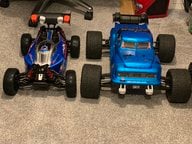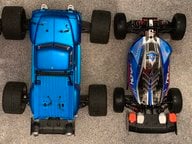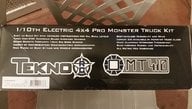Splattered23
Fairly New Member
- Messages
- 42
- Reaction score
- 6
- Arrma RC's
- Granite
- Senton 6s
- 4x4-Mega
So I've been looking at the Tacon Soar buggy for when I have more money to spend on another toy... wanting something a little smaller I can just run on pavement in parking lots and on streets. This is advertised as a 1/14 brushless buggy. Then I go look at the Typhon 3s today and it is listed as a 1/8 buggy the same as my Kraton.
However in looking at the actual vehicle dimensions online they appear to be very close to the same??? But one is a 1/14 and one is a 1/8.
I always thought that the higher the scaling number it is the smaller the vehicle - 24 and 32 being micro for example.
Is that not actually the case?
However in looking at the actual vehicle dimensions online they appear to be very close to the same??? But one is a 1/14 and one is a 1/8.
I always thought that the higher the scaling number it is the smaller the vehicle - 24 and 32 being micro for example.
Is that not actually the case?




